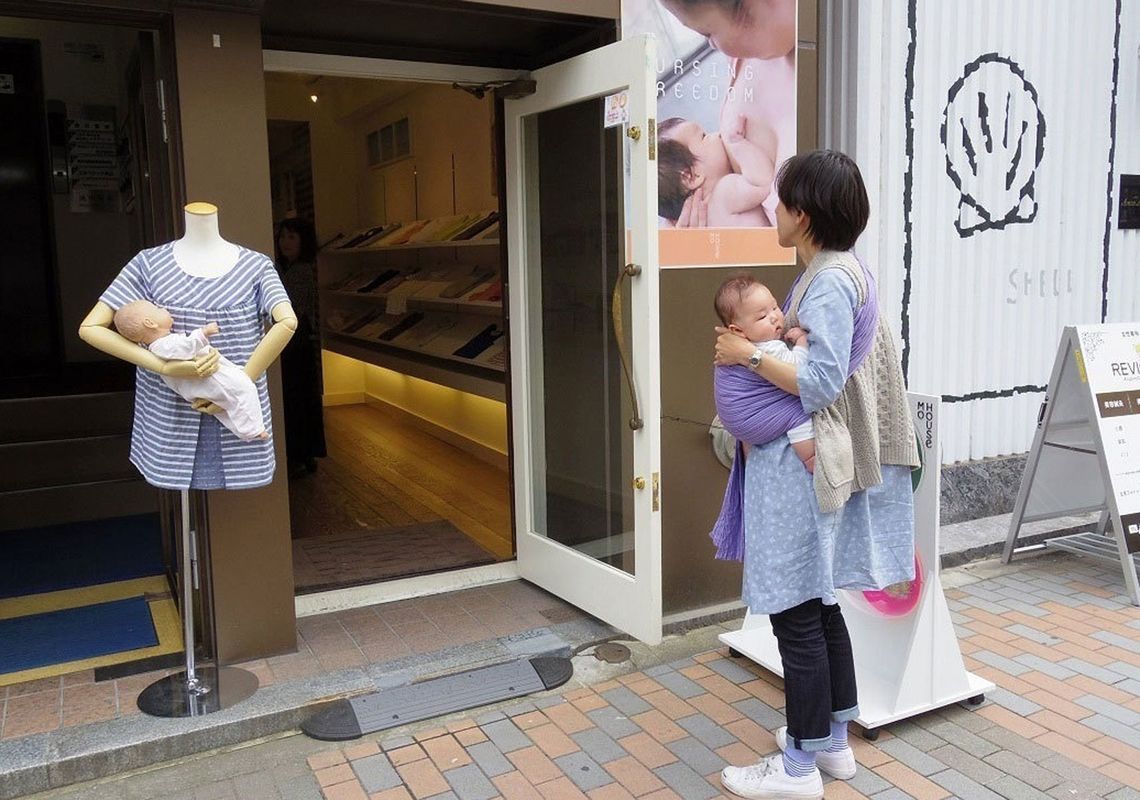
Most women who return to work after maternity leave have thought at least once that if only they could take their babies to work. Upon hearing about companies that implement the "take-your-child-to-work style,” I took my three-month old to see there.
Established in 1997, Mo-house is a nursing clothing maker that specializes in designing clothes that make it easy to feed your baby any time. The company has headquarter in Tsukuba Ibaraki and has stores in Tsukuba and Aoyama, Tokyo. When I visited their Aoyama store, a clerk with her baby in a sling welcomed me.
When you hear the words "working with children", you probably think you take children to the company with a daycare center. But that’s not the case at Mo-house. You can actually be with children while working.
Is it right to take my baby to work?
Before I visit the store, I had plenty of questions: Can the sales staff concentrate on their work? Don’t babies bother by crying out loud or touching everything. Is it right to take babies to work in the first place.
But all my worries were completely blown away as soon as I got into the store. Of course the babies would cry sometimes, but even if their mothers are busy with customers, they can be fed and calmed quickly. Many of customers come to the store with their own babies, so there is active communication among the staff and customers as well.
Ms. Aomi Ebisawa, who works at the Aoyama store with her 14-month old daughter, started working at Mo-house when her daughter was two-month old. Now her daughter tries to imitate her by trying to fold clothes and waving goodbye to customers who have finished shopping. It's as if she's also one of the team.
Sachiko Kobayashi, who is in charge of product development at the headquarter works with her 20-month old child. After driving to the office for 9 a.m., she begins her day by breastfeeding her child while checking emails. If her child becomes sleepy, she puts the baby down for a nap in the part of the office that has been set up as the sleeping area. At lunchtime they both eat a bento lunch together.
Making the workplace "baby-friendly"
During the afternoon, the children wander around the office. The office floor is carpeted and kept very clean, and due care is paid to make sure that there are no dropped paper clips or staples. "I often see my child sitting on another person’s knees. Children are always being looked after by our employees, so they grow up not to be afraid of strangers,” says Ms. Kobayashi.
But it was not easy to make the workplace “baby-friendly.” Mo-house has done plenty of things before the employees felt comfortable bringing their babies. For example, Aoyama store has a large number of staffs for a store this size, so that mothers can work with some flexibility.
Also, all the work duties are shared among all the staff members for the emergency situations like someone leaving work early for her sick child. They keep notes of their work, and they always make sure to CC every staff when they email to people outside of the company. When it is not possible to come to work, they can join meetings via Skype.
Until now Mo-house has employed 250 mothers. Concerning the issue of a large staff turnaround, Ms. Yuka Mitsuhata, CEO of the company says, “That may not be very efficient for a business, but I want women who are stuck at home alone with their children, or those that want to work but can't, to be able to take that first step back outside."
In fact, Ms. Mitsuhata herself once thought her working career would end when she had a baby. But her own experience of using nursing clothes when bringing up her child changed that view. She started thinking “things don’t end just because I had a baby, and quitting isn’t the only option.”
Working mom's pressure
Looking back 10 years ago when I had my first child, I felt as if the wall was my only friend. My husband didn’t come home till late at night and I didn’t have any close fellow mom. I spent my time only with my older son in a small room in my apartment. I remember how free I felt when I went back to work: reading newspapers and enjoying my coffee quietly at work.
On the other hand, I was always running around at work, at train stations, on the way to the daycare center, even in my house to take care of everything.
I was so nervous when I had to leave my sick child at the daycare. I pretended as if everything is fine, but deep down, I was so afraid of receiving a call from nursery staff who would tell me to pick up my child early because he is sick. I didn’t want anybody to think I am one those persons who "let everyone down at work because her child was ill.” If I could take my child to work, I might have been able to work under a little less pressure.
Of course there are probably those that say "You can't work with such frivolous thoughts," or "You're being greedy". However, this isn't a choice of "putting your child in daycare and being a full time worker" or "being a full time housewife", this is a flexible work style somewhere between the two. Just by having this choice, women can feel reassured.
